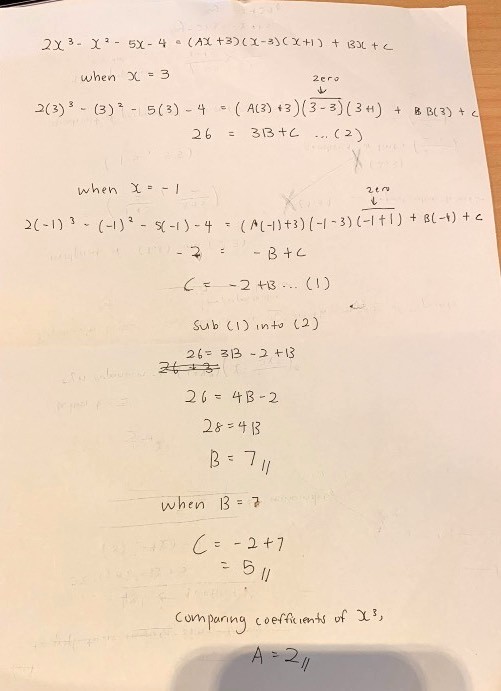Ask Singapore Homework?
Upload a photo of a Singapore homework and someone will email you the solution for free.

See 2 Answers
done
{{ upvoteCount }} Upvotes
clear
{{ downvoteCount * -1 }} Downvotes
Hope this helps!
Date Posted:
4 years ago
done
{{ upvoteCount }} Upvotes
clear
{{ downvoteCount * -1 }} Downvotes

Hope this helps !
Date Posted:
4 years ago
Finally, you are back on this forum. Welcome back!
I thought you used to prefer expanding and equating both sides, if I can still remember?
I thought you used to prefer expanding and equating both sides, if I can still remember?
Yes I use to prefer using that. But I find that this method which I just used is actually easier to understand . What do u think ?
It’s part and parcel of being an identity; any value of x must work in the equation, but even then, suitable choices of x simplify the identity more quickly.
This is why a lot of questions place a lot of thing like A (x - 3)^3 + B (x - 3)^2 + C (x - 3) + D, where they intentionally place lots of (x - 3) in the hopes that students would use an x value of 3 rather than use other approaches to do the question.
Of course, substituting other choices into the above equation will not be a good idea because the four unknowns still survive (unless the student is really bored and wishes to substitute x = 0, 1, 2, 4 and solving the four simultaneous equations to obtain the four unknowns).
Another possible approach is to directly compare coefficients without full expansion, especially for the highest and lowest powers of x.
The standard expansion is still the universal way which everyone will definitely understand, but the reason why I used to not like expansion (and many of my students do not do the expansion) is that the resultant expression gets very messy and the resulting simultaneous equations in three (usually three, not two) variables also take time to solve (my weaker students can do two equations in two variables but get stuck when there are three equations in three variables).
Ironically enough I taught one of my Sec 3 tuition students yesterday (who just learned polynomial yesterday under my care before the main school does so) to expand everything out.
Personally what I would do for this question is this (after some experience my strongest students are following my footsteps too).
1. Obtain A by comparing x3, since there is only one way we can get x3 on the RHS by multiplying the three x terms.
2. Obtain C by comparing coefficients (equivalent to using x = 0), now that we have found A, killing off the unknown B.
3. One unknown left B, so any method works - I use x = 1 this time.
This is why a lot of questions place a lot of thing like A (x - 3)^3 + B (x - 3)^2 + C (x - 3) + D, where they intentionally place lots of (x - 3) in the hopes that students would use an x value of 3 rather than use other approaches to do the question.
Of course, substituting other choices into the above equation will not be a good idea because the four unknowns still survive (unless the student is really bored and wishes to substitute x = 0, 1, 2, 4 and solving the four simultaneous equations to obtain the four unknowns).
Another possible approach is to directly compare coefficients without full expansion, especially for the highest and lowest powers of x.
The standard expansion is still the universal way which everyone will definitely understand, but the reason why I used to not like expansion (and many of my students do not do the expansion) is that the resultant expression gets very messy and the resulting simultaneous equations in three (usually three, not two) variables also take time to solve (my weaker students can do two equations in two variables but get stuck when there are three equations in three variables).
Ironically enough I taught one of my Sec 3 tuition students yesterday (who just learned polynomial yesterday under my care before the main school does so) to expand everything out.
Personally what I would do for this question is this (after some experience my strongest students are following my footsteps too).
1. Obtain A by comparing x3, since there is only one way we can get x3 on the RHS by multiplying the three x terms.
2. Obtain C by comparing coefficients (equivalent to using x = 0), now that we have found A, killing off the unknown B.
3. One unknown left B, so any method works - I use x = 1 this time.







